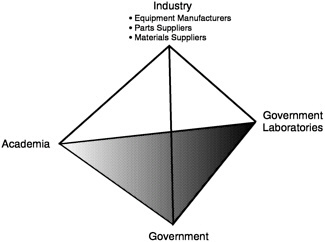Recent Studies and Symposia
A brief session focused on two reports of recent studies and symposia. Dale F.Stein of Michigan Technological University reviewed the results of a study he chaired recently. Dr. Stein is an emeritus professor of mechanical engineering at the University, where he was head of metallurgy engineering from 1971 to 1979 and president of the university from 1979 to 1991. He was elected to the National Academy of Engineering in 1987 for his work on materials deformation and fracture. Dr. Stein chaired the recently released National Materials Advisory Board study Materials Science and Engineering: Forging Stronger Links to Users (National Academy Press, 1999). His talk was a summary of that report. The following description is based on the executive summary of the report.
R.G.“Gil” Gilliland of Oak Ridge National Laboratory reported on discussions at a symposium on future materials needs. Dr. Gilliland is associate laboratory director of the Energy and Engineering Sciences Directorate of the Laboratory. Before joining Oak Ridge he held positions in industry and at the University of Wisconsin. Dr. Gilliland was on the organizing committee of Materials XXI, a symposium sponsored by ASM International a few weeks before the forum.
The following are summaries prepared by the editors who adapted them from the remarks made by the individual presenters.
Materials Science and Engineering: Forging Stronger Links to Users
This report2 is about relationships among the producers and users of materials—how to understand them and how to nurture them (Figure 1). It is also about the process of innovation, from the generation of knowledge through the development and application of a material to the ultimate integration of the material into a useful product. Figure 2 is a simple linear depiction of the phases of this process. Development processes in the real world are more like a series of iterative decision loops than Figure 2 suggests, and the report includes real-life case studies that provide a more accurate nonlinear depiction.
The committee developed the following definition, which both set bounds
on its task and captured the complexity of materials science and engineering:
To extend the usefulness of all classes of materials, the field of materials science and engineering seeks to understand, control, and improve upon five basic elements:
-
the life-cycle performance of a material in an application (i.e., in a component or system)
-
the design and manufacture of a component or system, taking advantage of a material’s characteristics
-
the properties of a material that make it suitable for manufacture and application
-
the structure of a material, particularly as it affects its properties and utility
-
the synthesis and processing by which a material is produced and its structure established
A new material or process is unlikely to be researched by the MS&E community and adopted by industry unless it satisfies the perceived needs of both groups. Successful commercialization by industry is driven by four forces: desire for cost reduction, desire for improvement in quality or performance, societal concerns manifested either in government regulation or in self-imposed changes to avoid regulation, and crises. Substantially different forces drive R&D: the availability of funding, the desire to expand the basic knowledge base, an educational mission, the desire for professional recognition, and the availability of equipment. Because of these differences, stronger linkages both within the MS&E community and with others who affect the community are key to accelerating the rate of introduction of new materials into the economy.
A key goal is to overcome the barriers to R&D in Phase 2 (material/process development). This phase is the “valley of death,” during which the driving force for innovation changes from “technology push” by researchers to “product pull” by end users. Accelerating this transition requires an environment in which (1) innovations are desired and anticipated by those who will use them and (2) researchers address business considerations early in the development process.

FIGURE 1 Relationships in the materials science and engineering community.
To establish product pull early in the process—in Phase 1 (material concept development) or perhaps even Phase 0 (knowledge-base research)— the following should be given priority: the following should be given priority
-
consortia and funding mechanisms to support precompetitive research
-
industry road maps to set priorities for materials research
-
university centers of excellence to coordinate multidisciplinary research and facilitate industry-university interactions
To improve the transition from Phase 2 to product implementation, the following should be given priority:
-
collaboration with end-user industries to identify the data product designers need to assess new materials and processes
-
investigation of ways to improve the research infrastructure for materials suppliers and parts suppliers
-
extension of the patent-protection period, especially for applications that require lengthy certification
-
development of industrial ecology as an integral part of the education and expertise of both researchers and product designers
-
development of a regulatory climate based on constructive cooperation and goal setting
The study also includes more detailed findings and recommendations. It is available at <http://books.nap.edu/catalog/9718.html>.
Materials XXI
The purpose of Materials XXI was to identify market needs for the twenty-first century. Presentations addressed the following topics:
-
communications/electronics
-
aerospace and defense
-
energy
-
future needs of developing nations
-
ground transportation
-
agricultural equipment
-
heavy/capital equipment
-
infrastructure/construction/residential
Issues discussed at the symposium were the subject of subsequent editorials in the ASM journal Advanced Materials & Processes. For more information, contact Peg Hunt at <mwhunt@po.asm-intl.org> or 440–338–5151.

FIGURE 2 Notional phases of the materials innovation process.2



